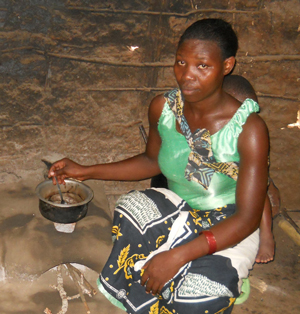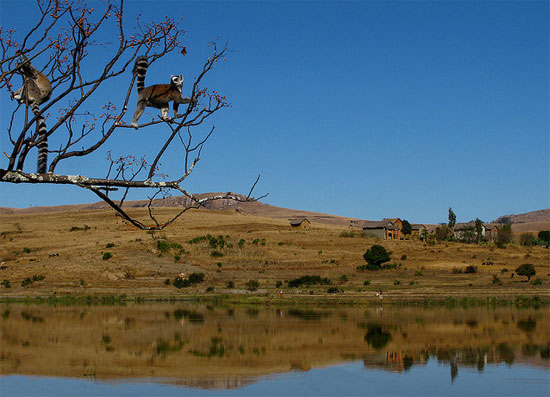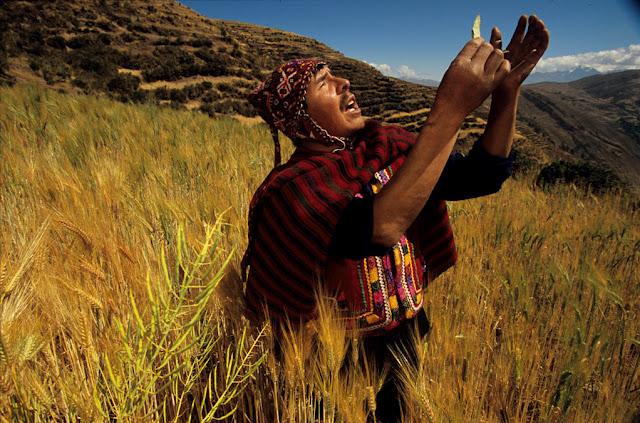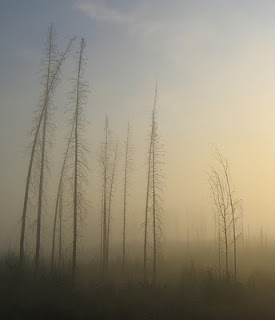-
Rukia Seif, PHE Champion
Making Life Easier in Rural Tanzania
›This PHE Champion profile was produced by the BALANCED Project.
Rukia Seif is a population, health, environment (PHE) peer educator who promotes simple economic, environmental, and health behaviors that make sense. In many ways, the Mkalamo village where Rukia lives is a typical rural Tanzanian agricultural village. In another important way it is very different. Mkalamo abuts the biodiversity rich Saadani National Park – the only wildlife park in Tanzania that borders the sea. Ironically, this park does not make life easier for people living in Mkalamo but more difficult. In the park, there is a ban on the cutting of wood, making it difficult to find enough to fuel villagers’ cooking stoves. Also, increasing numbers of the park’s wild animals often destroy the villagers’ precious crops.
As a PHE peer educator, Rukia talks with her fellow community members about simple things they can do to improve their lives. Her messages are clear:
Rukia sets a good example of how doing these simple things can improve a family’s life and protect the environment. At age 36, she is a mother of three girls, ages 14, 12, and one and a half. Rukia and her husband, Seif Ramadhani, are taking measures to plan their family. Rukia used pills before they decided to have their last daughter. Now they are using condoms as a back-up while Rukia is breastfeeding the baby. Through her work, Rukia meets and talks to many people every day. She discusses family planning and if someone is interested, she refers them to community-based distributors and the dispensary for family planning services.- By planning their families, women can ensure their own and their children’s health and can decide the optimal number of children that they can provide for.
- By using fuel efficient stoves, women can spend less time collecting fire wood, freeing up time for other chores or livelihood activities and reducing the amount of needed fuel, thus helping sustain the forests for future generations.
- By joining community-led savings and credit associations, women and men gain access to capital, allowing them to scale-up current livelihoods or diversify to new sources of income.
“I talk to my peers about planning their families so we have enough natural resources to meet the needs of the villagers who depend on these resources,” she said. “Also, when you plan your family, you will get more time to perform other activities.”
An active member of the savings and credit association, where she also acts as the accountant, Rukia is living proof of this last statement. Through savings and loans, Rukia has diversified her income by buying a sewing machine and a fuel-efficient oven. Today, she generates income from cow and poultry husbandry, tailoring, bread-making, selling soft drinks, and constructing fuel-efficient stoves. With this increased income, Rukia and her husband have been able to put an iron sheet roof on their house and send their first-born daughter to secondary school – a great achievement in a country where only five percent of women stay in school beyond the primary level.
Rukia demonstrated her two fuel-efficient stoves: one is a metal oven that she uses for baking breads and cakes, the other is a simple mud stove that she uses for cooking. The mud stove, which costs less than $2 to build, is getting increasingly popular in the community. It saves fuel wood, prevents fires, produces less smoke (a serious health hazard), and cooks the food faster!
“I can even wear my best clothes and put on some lip shine when I use this stove, because it does not foul up the air,” Rukia explains with a laugh. Seeing the benefits of the fuel efficient stoves, she has inspired ten community-based distributors and five village leaders to join the team of individuals showcasing the fuel efficient technologies.
Rukia is a perfect example of practicing what one preaches. She is improving her own life, helping others learn to do the same, and protecting the very natural resources upon which almost everyone in Mkalamo depends.
This PHE Champion profile was produced by the BALANCED Project. A PDF version can be downloaded from the PHE Toolkit. PHE Champion profiles highlight people working on the ground to improve health and conservation in areas where biodiversity is critically endangered. -
Our Shared Future: Environmental Pathways to Peace
›Download Our Shared Future: Environmental Pathways to Peace from the Wilson Center.
How does globalization affect natural resource issues such as water on local, national, and international levels? Can our common dependence on these stressed resources be a force for bringing people together rather than dividing us? What lessons can we learn from sharing insights from communities at these very different levels of organization?
Pathways to Peace
In January 2010, the Woodrow Wilson International Center for Scholars and the Fetzer Institute invited 22 scholars and practitioners to a two-day seminar to discuss these questions and the deep connection between caring for the environment and caring for community. Pathways to Peace: Defining Community in the Age of Globalization was the second seminar in a three-year initiative to combine scholarship, public policy, and local practice to articulate and support global conflict transformation and reconciliation in communities throughout the world. Examining the effect of environmental peacebuilding on communities, the discussion explored how governments, NGOs, the private sector, and other interested parties can generate positive outcomes while minimizing negative ones.
Participants from Canada, Ecuador, Ethiopia, Israel, Kenya, Nepal, Switzerland, the Philippines, and the United States brought to the table a wide range of experience and expertise from diverse fields, including peacebuilding, community building, health care, economic development, conflict resolution, and foundation management. By convening leaders in environmental peacebuilding and community building, the Wilson Center and the Fetzer Institute drew on a wide range of experience and perspectives related to environment, conflict, and peacebuilding practice and research. The group used water access and peacebuilding case studies as a means to enter into dialogue about the challenges of global community engagement.
Shared Waters
In preparation for the seminar, geographer and renowned water expert Aaron Wolf of Oregon State University contributed a paper, “The Enlightenment Rift and Peacebuilding: Rationality, Spirituality, and Shared Waters,” in which he laid out the complicated, sometimes conflictual, and often surprisingly collaborative aspects of negotiations over water resources. For Wolf, given water’s life-sustaining quality but limited quantity, it seems intuitive that “water should be the most conflictive of resources.” However, he maintains that “while press reports of international waters often focus on conflict, what has been more encouraging is that, throughout the world, water also induces cooperation, even in particularly hostile basins, and even as disputes rage over other issues…there is a long, and in many ways deeper, history of water-related cooperation.”
On this foundation, Wolf illustrates four stages of water conflict: from adversarial, to reflective, to integrative, to action. Lessons from the “spiritual understanding of water conflict transformation” he says, “offer not only new understanding of current disputes, but also models, tools, and strategies for more effective water conflict management and transformation.”
Seminar participants used Wolf’s paper as a starting point from which to write short papers based on their own expertise and experience. From Kenya to Nepal to Harlem, participants shared their perspectives on the challenges and promises of environmental issues, community building and organizing, and peacebuilding.
This report, Our Shared Future: Environmental Pathways to Peace, draws from the rich dialogue of the seminar and seminar papers to share the broad range of experience and the insight of the participants. To learn more about these remarkable programs and the people working on natural resources, peacebuilding, and community development, see the complete list of papers on page 120, which can be downloaded from the Wilson Center. -
Integrating Development: A Livelihood Approach to Population, Health, and Environment Programs
›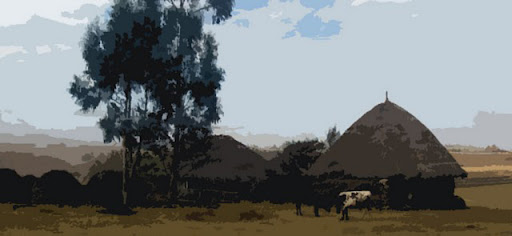
Rural communities in developing countries understand that high population growth rates, poor health, and environmental degradation are connected, said Population Action International’s Roger-Mark De Souza at a recent Wilson Center event. An integrated approach to development – one that combines population, health, and environment (PHE) programs – is a “cost-effective intervention that we can do very easily, that responds to community needs, that will have a huge impact that’s felt within a short period of time,” said De Souza. “This is how we live our lives, this makes sense to us – it’s completely logical,” community participants in PHE projects told him.
-
Madagascar, Past and Future: Lessons From Population, Health, and Environment Programs
›In Madagascar, “today’s challenges are even greater than those faced 25 years ago,” said Lisa Gaylord, director of program development at the Wildlife Conservation Society. At an event at the Woodrow Wilson Center on March 28, Gaylord and her co-panelists, Matthew Erdman, the program coordinator for the Population-Health-Environment Program at Blue Ventures Conservation, and Kristen Patterson, a senior program officer at The Nature Conservancy, discussed the challenges and outcomes of past and future integrated population, health, and environment (PHE) programs in Madagascar. [Video Below]
Nature, Health, Wealth, and Power
Gaylord, who has worked in Madagascar for nearly 30 years, gave a brief history of USAID’s activities on the unique island, which she called a “mini-continent.” She used the “nature, health, wealth, and power” framework to review the organization’s environment, health, and livelihoods programs in Madagascar and their results. Governance, she said, is the centerpiece of this framework, but this piece “maybe didn’t have an adequate foundation” in Madagascar to see the programs through the political crisis.
Though its programs started at the community level, Gaylord said USAID’s objective was to scale up to larger levels. “You can’t always work on that level and have an impact,” she said, and there was “tremendous hope” in 2002 for such scaling up when Madagascar elected a new president, Marc Ravalomanana.
Unfortunately, changes in funding, a lack of economic infrastructure, and poor governance forced development programs to scale down. After President Ravalomanana was overthrown in a military coup in 2009, the situation got worse – the United States and other donors pulled most funding, and only humanitarian programs were allowed to continue.
“What worries me is that I think we have gone back” to working on a village level, Gaylord said. “We want to go up in scale, and I think that we felt that we could in Madagascar, but that’s where you have the political complexities that didn’t allow us to continue in that direction.”
Going forward, Gaylord said that it is important to maintain a field-level foundation, take the time to build good governance, and maintain a balance in the funding levels so that no one area, such as health, dominates development activities.
Living With the Sea
Based in southwestern Madagascar, the Blue Ventures program began as an ecotourism outfit, said Erdman, but has since grown to incorporate marine conservation, family planning, and alternative livelihoods. One of its major accomplishments was the establishment of the largest locally managed marine protection area in the Indian Ocean, called Velondriake, which in Malagasy means “to live with the sea.” This marine area covers 80 kilometers of coastline, incorporates 25 villages, and includes more than 10,000 people. The marine reserves for fish, turtles, and octopus, as well as a permanent mangrove reserve, protect stocks from overfishing.
One of the biggest challenges facing the region is its rapidly growing population, which threatens the residents’ health and their food security, as well as the natural resources on which they depend. More than half the population is under the age of 15 and the infant and maternal mortality rates are very high, Erdman explained. Blue Ventures, therefore, set up a family planning program called Safidy, which means “choice” in Malagasy.
“If you have good health, and family size is based on quality, families can be smaller and [there will be] less demand for natural resources, leading to a healthier environment,” said Erdman.
The region’s isolation and lack of education and health services are a challenge, said Erdman, but over the past three years, the contraceptive prevalence rate has increased dramatically, as has the number of clinic visits. The program uses a combination of clinics, peer educators, theater presentations, and sporting events, such as soccer tournaments, to spread information about health and family planning.
A Champion Community
“There is a long history of collaborative work in Madagascar,” Patterson said. Focusing on the commune (county) level, she worked in conjunction with USAID, Malagasy NGOs, and government ministries to try to scale up PHE programs in Madagascar’s Fianarantsoa province, which has a target population of 250,000 people.
“We essentially worked at two different levels,” said Patterson. At the regional level, a coordinating body for USAID and local partners called the “Eco-Regional Alliance” met monthly. The “Champion Commune” initiative, which worked at local levels, had three main goals, she explained:
Though working in such remote areas is expensive, and all non-humanitarian U.S. foreign aid has been suspended since the coup, Patterson hopes that development programs will return to Madagascar. Pointing to its vast rural areas, she stressed the importance of integrated efforts: “The very nature of multi-sectoral programs is that they have the highest benefit in the areas that are most remote. These are the areas where people are literally left out in the cold.”- Create a strong overlap with neighboring communes;
- Promote activities that benefited more than one sector (such as reforesting with vitamin-rich papaya trees); and
- Capitalize on the prior experiences of Malagasy NGOs in implementing integrated projects to help build up civil society.
Image credit: “Untitled,” courtesy of flickr user Alex Cameron.
Sources: The New York Times, Velondriake. -
What “Lost” Cultures Can Contribute to Management of Our Planet
›
“Climate change is not a technical problem for indigenous people – it’s a psychological and spiritual problem,” said Wade Davis, explorer-in-residence at National Geographic, at a recent Wilson Center event, the third in a series co-sponsored by George Mason University and the Environmental Change and Security Program. Indigenous people are “being driven out of existence,” as climate change alters landscapes and weather patterns that they have carefully adapted to over centuries, he said. These people are not “failed attempts at being modern…they are unique answers to the fundamental question, ‘what does it mean to be human and alive?’” he said. “It behooves us to pay attention to how they choose to live upon the earth.” [Video Below]
-
‘The Fence’ on U.S.-Mexico Border: Ineffective, Destructive, Absurd, Say Filmmakers
›April 5, 2011 // By Wilson Center StaffThe documentary The Fence, directed by Rory Kennedy, “shows a strong case against a single-minded approach to securing the border,” said Mexico Institute Program Associate Robert Donnelly at a Wilson Center screening on March 23. Part of the DC Environmental Film Festival, the screening was co-sponsored by the Environmental Change and Security Program and the Mexico Institute.
The film documents the $3 billion dollar construction of a 700-mile-long fence, which runs intermittently along the 2,000-mile-long U.S.-Mexico border. The barrier, a result of the Secure Fence Act of 2006, was intended to keep out terrorists, drug traffickers, and unauthorized border-crossers. Yet, according to the film, it is a solution in search of a problem. No terrorist has ever entered the country by illegally crossing the southern border; the 9-11 hijackers all had visas and arrived in the country by air, the film notes.
Physical barriers also have not reduced the rates of contraband drug smuggling into the United States, in spite of the claims of fence hawks, the film argues. And the numbers of undocumented immigrants in the United States actually rose over 1994-2009, the period covered in the film. At the same time, the construction and maintenance of physical barriers along the southern border have had adverse humanitarian, environmental, and fiscal consequences.
The film’s wry narration pokes fun at the “absurdity” of a fence that stops and starts at different places along the border. But this absurdist tone does not detract from one of the film’s more serious messages: that border fencing has coincided with an increase in migrant deaths from 1994 through 2009.
In a discussion following the screening, Geoff Dabelko, director of the Environment Change and Security Program, said that it is unlikely the fence will be torn down anytime soon given the money spent on its construction. Donnelly pointed out some adverse environmental effects of border fencing, such as the disruption of migration patterns for certain animal species. The film notes that the normal environmental review process for projects of its kind was waived by the Department of Homeland Security, which cited the importance of the border fence to national security.
The discussants acknowledged that the border fence is ill equipped to single-handedly stop the traffic in contraband or to significantly stem unauthorized migration. Instead, immigrant-sending and -receiving countries should work together to develop policy options that better address the root economic causes that prompt unauthorized migration.
Dana Deaton is an intern with the Mexico Institute at the Wilson Center. -
Forest Conservation Method a Fit for Canada’s Oil Sands?
›In Wednesday’s speech on U.S. energy security, President Obama stated clearly that the United States would continue to rely on oil imports from Canada and other stable nations. But serious environmental concerns continue to dog the Canadian oil sands industry. Could an agreement reached by Canada’s Forest Products Association provide a model for a way forward?
In May 2010, the Canadian Boreal Forest Agreement (CBFA) was signed by 21 members of the Forest Products Association of Canada (FPAC) and nine major environmental groups, including Greenpeace, the Nature Conservancy, and the Pew Charitable Trusts, without government involvement. The three-year agreement represents the largest forest conservation plan in history and protects more than 72 million hectares of Canada’s Boreal Forest. It also ended a long “do not buy” campaign of FPAC products, previously spearheaded by environmental organizations.
The CBFA essentially commits FPAC to the highest environmental standards of forest management and conservation, as well as the suspension of logging in environmentally sensitive areas, in part to protect endangered caribou populations. In return, environmental organizations agreed to support FPAC members.
The oil sands industry faces a similar challenge. In both cases, industry and environmental NGOs have clashed in a long and bitter battle over industry practices and their impact on the environment. The difference is that FPAC realized that directly engaging environmental groups in reasoned discussion might be a more intelligent approach to resolving environmental challenges than shouting back and forth at one another. FPAC also believes that buyers will be attracted to their newfound reputation for sustainable practices and higher ethical standards.
Model Agreements
Oil sands producers have much to gain by engaging the environmental community in new and innovative ways Should the CBFA model be followed, the oil sands industry may be able to negotiate an agreement with environmental organizations and voluntarily agree to higher environmental standards in return for recognition and support of their efforts from key environmental organizations.
This wouldn’t be the first initiative where creative engagement between environmental organizations and industry served to mutually benefit both sides. For instance, in 1999, WWF and Unilever created the Marine Stewardship Council (MSC), a program that rewards fisheries employing environmentally sustainable practices by recognizing their efforts through MSC certification and eco-labeling. Member fisheries maintain that MSC labeling has helped them retain existing markets, expand into others, and in some cases obtain a price premium for their product.
Such an initiative would go a long way to allow oil sands producers to shed their damaging reputation for producing “dirty oil.” Even if an agreement could not be reached, the oil sands industry would be viewed at the very least as willing to listen to the concerns of environmental organizations and take such issues seriously.
Not Perfect, But It’s a Start
The CBFA model may not be a perfect fit for the oil sands but it demonstrates that environmental groups and industry can find common ground on extremely contentious issues.
Finding this common ground must begin with accepting that the oil sands will never be “green.” According to a study by the Royal Society of Canada, in 2008, oil sands mining and development operations covered an area roughly the size of the state of Illinois and was responsible for emitting nearly 37 million tons of CO2. The study also found that there are legitimate concerns regarding the impact of oil sands development on the quality and quantity of regional freshwater supplies.
Nevertheless, the oil sands also represent a critical source of stable energy supplies for Canada and the United States, and calls by some environmental NGOs to halt oil sands production are unrealistic. More than 20 percent of U.S. oil is sourced from Canada, making it the United States’ leading supplier, and roughly half of that comes from the oil sands.
A CBFA-style agreement could help oil sands producers secure the U.S. market, which currently takes 99 percent of Canada’s oil exports, by quelling campaigns in the United States to stop imports from the oil sands. And under an agreement similar to the CBFA, the environmental community could have a larger say in how it is developed and extracted
As it stands, both industry and the environmental community remain engaged in a heated war of words, with neither side really listening to the other. Until they are willing to sit down and engage each other in new ways, both groups are likely to continue to talk over one another and make little progress on striking an environmental and economic balance that could ultimately benefit both sides.
Ken Crist is a program associate with the Canada Institute at the Woodrow Wilson International Center for Scholars.
Sources: Sources: The Canadian Boreal Forest Agreement, National Resources Defense Council, The New York Times, Royal Society of Canada, Vancouver Sun.
Photo Credit: “Athabasca oil sands digger,” courtesy of flickr user . Shell, and “Boreal forest 2009,” courtesy of flickr user Gord McKenna. -
The Impact of Environmental Change and Geography on Conflict
›“Environmental Change, Strategic Foresight, and Impacts on Military Power,” published in Parameters by Chad M. Briggs, the Minerva Chair of Energy and Environmental Security at the Air University, USAF, tackles the changing definition of “environmental security” and how the concept can help planners better prepare for the effects of climate change and an elevated focus on energy security. New potentially destabilizing issues like glacial melt, sea-level rise, and Arctic ice melt are on the horizon, writes Briggs. China and others are already planning for these events, and it’s important that the United States does the same, starting with a greater appreciation for the impact of environmental security on vulnerability and risk. “Due to past practices and bureaucratic stovepipes, implementation is limited more by initiative and imagination than actual resources,” he writes.
Clionadh Raleigh of Trinity College Dublin and the International Peace Research Institute finds in “Seeing the Forest for the Trees: Does Physical Geography Affect a State’s Conflict Risk?” that a region’s geography does not have a uniform effect on its likelihood of experiencing conflict. Raleigh’s conclusions, published in International Interactions, run counter to traditional histories which often emphasize the importance of physical geography, specifically with regard to civil war and insurgencies. Focusing on the Great Lakes region of Africa, Raleigh finds that other factors – like how populated an area is and its proximity to valuable natural resources – correlate higher with an area’s propensity for violence than any other factor.
Showing posts from category environment.


